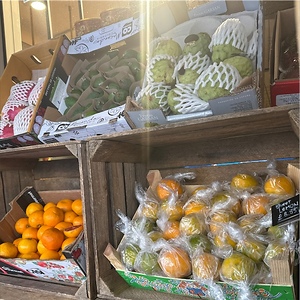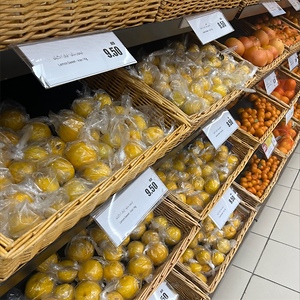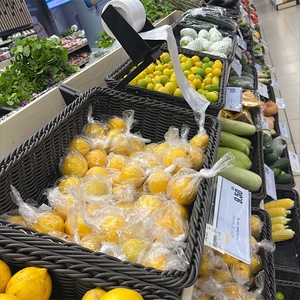


Iranian Sweet Lemons
Estimated Inventory, lb : 0
Description/Taste
Iranian Sweet lemons are a small to medium-sized varietal, averaging 5 to 6 centimeters in diameter, and have a plump, round, oblate shape with curved ends and one side featuring a small point. The lemon’s skin is thin, smooth, and glossy, covered in sunken oil glands, giving the surface a slightly pitted texture. When scraped or rubbed, Iranian Sweet lemons are known for releasing aromatic oils from these glands, giving them a robust scent. The fruit’s surface also ripens from green to yellow-green or golden-yellow shades. Underneath the surface, a thin layer of spongy white pith tightly clings to the pale yellow-green to golden yellow flesh. The pulpy flesh is divided into 8 to 9 segments by thin membranes and is aqueous, soft, and tender, containing a few to many cream-colored seeds. Iranian Sweet lemons should feel heavy for their size when ripe and are known for their aromatic scent. The fragrance is said to smell like a combination of flowers such as roses, jasmine, and orange blossom mixed with lemon peel, pine, and green nuances. When ripe, Iranian Sweet lemons are edible raw and have a delicate, subtly sweet, and one-dimensional, sugary taste.
Seasons/Availability
Iranian Sweet lemons are available in the late summer through early spring, with a peak season in the winter.
Current Facts
Iranian Sweet lemons, botanically classified as Citrus limetta, are a category of sweet citrus varieties belonging to the Rutaceae family. The lemons are commercially produced in Iran and are also planted in home gardens. Iranian Sweet lemons are valued for their high vitamin C content, sweet taste, and juicy nature. It is said the fruits are known more for their fragrance than their delicate flavor, and the aroma often fills a room, evoking a sensory experience. Iranian Sweet lemons are also associated with refreshing beverages and are seasonally enjoyed by both adults and children. The name Iranian Sweet lemon is a general descriptor for sweet lemon varieties grown and sold in Iran. The species is also known by several other regional names worldwide, including Limoo Shirin, Limu Shirin, Persian Sweet lemons, Sweet lemons, Mitha Nimbu, Mousami, and Mousambi. Iranian Sweet lemons grow on evergreen trees reaching 4 to 8 meters in height, and the trees are characteristically thorny, available in dwarf, semi-dwarf, and standard sizes. Iranian Sweet lemons are hand-harvested once ripe and are a seasonal delicacy incorporated into a wide array of beverages, culinary dishes, and medicinal practices.
Nutritional Value
Iranian Sweet lemons are a source of vitamin C to boost the immune system. In Iran, the lemons are a trusted natural remedy given to children at the first signs of a cold or flu. The high vitamin C content is thought to help eliminate sickness, and the lemons are served as a juice or in wedges eaten with tea. Iranian Sweet lemons also provide potassium to balance fluid levels within the body, phosphorus to repair tissues, magnesium to control nerve functions, calcium to build strong bones and teeth, and other nutrients, including iron, copper, and B vitamins. In other natural medicines of Iran, Sweet lemons are mixed with hot water and honey to soothe sore throats and remove toxins from the body. The fruit’s sweet juice is also thought to stimulate the appetite and act as a natural diuretic. Once the juice is removed from the fruit, alkaline substances in the juice will begin to oxidize. This oxidization may cause the juice to turn bitter after a period of time.
Applications
Iranian Sweet lemons have a sweet, acid-less flavor and aromatic fragrance suited for fresh and cooked preparations. The variety is most famously consumed out of hand and is cut into wedges. Once sliced, Iranian Sweet lemons can be served with black tea, either squeezed into the tea or eaten similarly to an orange slice as an accompaniment to the beverage. It is said the sweetness of the fruit’s juice helps to mellow the tannins found in some black teas. Iranian Sweet lemons can also be pressed into juices and lemonades without the need for added sugar. It is important to note that the juice will initially be sweet but may develop a bitter taste over time due to the presence of alkaline substances in the juices oxidizing with the oxygen in the air. In addition to beverages, Iranian Sweet lemons are sliced and tossed into salads, served as an edible garnish over seafood, or utilized in various dressings, syrups, sauces, and marinades. The lemons can also be incorporated into chutney or simmered into jams, jellies, and marmalades. The sweetness of the fruits is used to flavor cheesecakes, cookies, dried doughnuts, and cakes, and a popular frozen ice dessert known as faloodeh mixes lemon juice with rose water. Iranian Sweet lemons can also be dried and added to salt, or the zest can be grated over soups, main dishes, desserts, and grain-based dishes. Iranian Sweet lemons pair well with spices such as cumin, black pepper, and ginger, herbs including mint, basil, and lemongrass, nuts such as almonds, walnuts, and pine, and fruits including strawberries, mangoes, grapes, and blueberries. Whole, unwashed Iranian Sweet lemons will keep for 1 to 2 weeks when stored at room temperature and 2 to 8 weeks when kept in the refrigerator. Fresh juice may also be frozen for up to six months, and fruit slices can be frozen in simple syrup.
Ethnic/Cultural Info
Iranian Sweet lemons are traditionally incorporated into sharbat, a general descriptor for homemade juices and syrups. The Persian name sharbat stems from the Arabic word “sharba,” meaning “a drink” or “shariba,” meaning “to drink.” Sharbat is considered one of the oldest beverages served throughout Iran, previously known as Persia, and the drink was either made from freshly squeezed juice or syrup mixed with water, cane juice, and ice. Creating syrups was a practice that allowed families to save fruits for year-round use, and the chilled drinks were especially favored as a reprieve from sweltering summer days. Sharbat was recorded in medicinal texts as early as the 11th century in the Canon of Medicine, a five-volume encyclopedia written by Ibn Sina, the father of early modern medicine in Persia. In the text, sharbat was believed to have medicinal properties from the infused fruits and herbs that could help various ailments. Sharbat continued to be recorded in medicinal texts throughout the 12th century, and in the 13th century, recipes were shared across the Silk Road, eventually expanding in use to other countries such as Turkey, Azerbaijan, China, and India. In Persia and later Iran, sharbat beverages were chilled with ice created from manmade pits. At the time, refrigeration and ice production had not yet been created. The Persians constructed an underground site where a thin layer of water could be flushed in and naturally frozen overnight. Once frozen, the ice would be transferred to a yakchal, a domed pit that could keep the ice cold. This ice-making method was used up until the 1960s. In the modern day, Iranian Sweet lemons are a popular ingredient for freshly squeezed sharbat, and these beverages are typically associated with happy occasions, served at religious events, celebrations, gatherings, and spending time with houseguests.
Geography/History
Iranian Sweet lemons are descendants of wild citrus varieties native to Asia. Much of the history of Iranian Sweet lemons is unknown, but the species thrives in warm and humid tropical to sub-tropical climates. Iranian Sweet lemons have been present in Asia for centuries, and over time, their use has spread along trade routes, expanding their presence as a culinary and medicinal ingredient. The fruits were also commercially grown in Iran for export to neighboring countries as an income source. Today, Iranian Sweet lemons are planted in the southern provinces of Hormozgan, Kerman, Mazarandran, and Fars and in the cities of Gilan and Gorgan. The fruits are also grown in select northern provinces. When in season, Iranian Sweet lemons are sold through local markets throughout Iran. They are also grown in home gardens. Outside of Iran, the variety is exported to other countries, including India, the United Arab Emirates, and spots in the Middle East, Asia, North America, and the Mediterranean. In the United States, the fruits are sometimes seen at specialty Persian grocery stores, especially in Los Angeles. The Iranian Sweet lemons featured in the photograph above were sourced through the Union Co-Op Hypermarket in Dubai.










